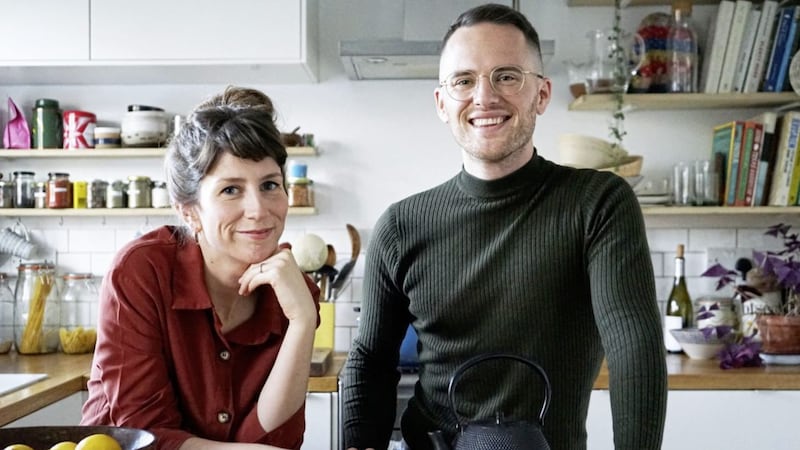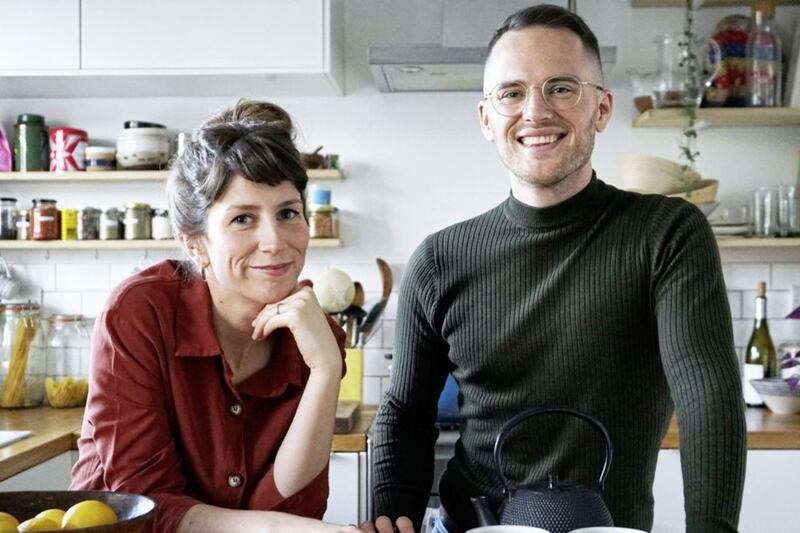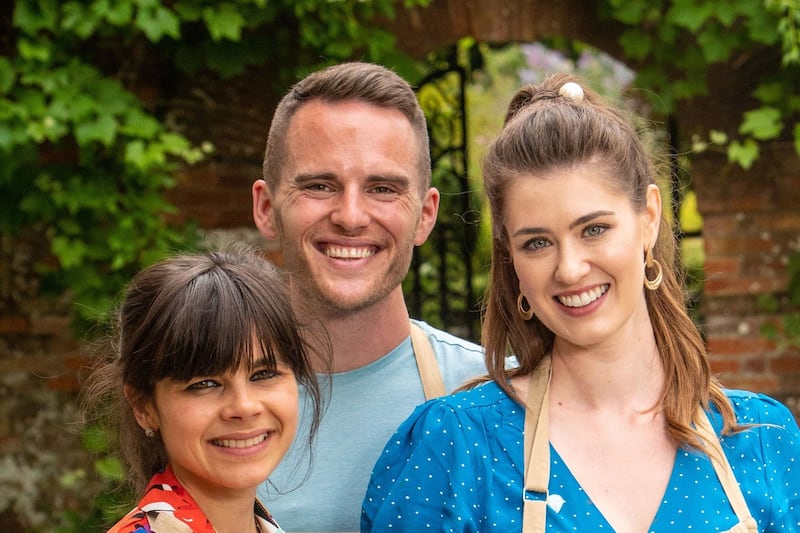GREAT British Bake Off 2019 winner David Atherton was “already having a bit of a crazy year” – so throw in the pandemic and “it’s just added to it.”
The 37-year-old health professional was that rare contestant in the feted tent: a calm, collected baker – qualities that have bolstered him during the post-win melee. “Everything is all new and very exciting, but also you feel very lost and you feel like you don’t know what you’re doing,” he says frankly. “You just want to be able to take the opportunities without burning out, basically.”
It’s a pragmatism that has also served Atherton well during the pandemic. He’s been teaching his partner Nik to make sourdough (“Now I can’t get near the bread!”), crafting (they made a quilt together), cooking (“There’s been a lot of positives, as well as all the scariness”) and encouraging people to sign up to a symptom tracker. And now, he’s celebrating his debut cookbook – although it might not be what you’d expect from a classic Bake Off winner.
For starters, My First Cook Book is for kids, and second, it’s not a glorification of sugar-spun, candied concoctions. Instead, its bedrock is Atherton’s nutrition background, and his interest in how “people who had an upbringing like myself, where their mum was in the kitchen with them all the time, tend to understand food and diet better”, he explains.
“My mum was very different, it’s funny because she would definitely be called hipster now, but back then she was called ‘hippie’,” he says fondly. “She had five kids and had to feed us all, and cooking from scratch is obviously the cheapest way – and also the healthiest.”
Atherton recalls how they had a small house but a big garden, which was filled with vegetable patches, chickens and an apple orchard: “Food was just one of the things we did. We weren’t allowed to watch TV really,” he continues, “so we had to spend our lives playing with each other and cooking and baking. It was idyllic.”
The most amazing thing, he says, was that his mum whipped up homemade bread for the seven of them. “We never had shop-bought bread – and she saw that as a way of keeping us entertained. She made massive batches twice a week, and as kids we would spend the whole morning playing with bread dough. I’m not sure how much of that got cooked and eaten…”
She didn’t shy away from letting them use knives either. “We were allowed to stir pots on the stove, use a knife to cut things, and crack our own eggs – and yes we would get shell in, but [with that attitude], by the age of three you can crack an egg!”
He says he still meets adults today “who can’t crack eggs properly”, and so the idea of My First Cook Book is to get all ages in the kitchen, learning about food, and spending time together. “It’s really important to capture kids young, and instead of trying to make it seem like a chore, food’s got to be fun,” Atherton enthuses.
The book is charmingly illustrated by Rachel Stubbs, a friend Atherton lodged with when he first moved to London, and funnily enough, the pair of them bagged their cookbook deal even before Atherton appeared on Bake Off.
Stubbs’s illustrations are key to the book’s whole ethos; they’re an antidote to the heavily curated, highly stylised, impossibly beautiful food photos you scroll through on Instagram and leaf through in cookbooks. “I mean, I’m guilty of it as well,” admits Atherton, “[but] in books, it’s been done by a qualified food stylist. They are incredibly stylish in how they present it. Then you’ve got professional photographers and lighting doing all kinds of tricks to make [the food] look super shiny and beautiful.
“For kids especially, to see that and then to try and mimic it – when even if they follow the recipe perfectly, it can’t look like this Instagram-standard photo – I just thought it’d be so nice to have an illustration where it’s not a real representation of the final thing. So therefore, whatever the kids produce, that’s what it should look like.”
There’s a mix of sweet and savoury dishes to try, from a ‘magic’ tomato sauce Atherton makes all the time, to octopus-shaped pizzas, tacos, sushi and veggie summer rolls. They largely offer an alternative route, one that moves away from capturing kids’ attention purely through sugar.
“In the same way that if a child is brought up with McDonald’s, they probably think a dried fig is disgusting,” muses Atherton. “I remember physically feeling sick when I’d see people spreading butter on bread before jam. We just put peanut butter or jam straight on, without anything else. It’s just, you’re conditioned. That’s why it’s so important to start with kids, because if you condition people to think that lots of refined sugar is normal, then your tastes will be very, very sweet.”
Atherton himself was the kid who preferred dense wholemeal loaves to pappy white bread, and didn’t hanker for Happy Meals. “Even now, Coca Cola, I just don’t understand it, because I never had it growing up. It just seems to be such a strange sweet taste to me.”
It does frustrate him that, although people are increasingly baking and cooking rather than relying on shop-bought, “there has definitely been a skewing towards these brightly coloured mountains of buttercream, which are just not good for anyone.
“There’s no reason to always use just butter, sugar and eggs,” he continues, “when we have amazing vegetables like sweet potato, butternut squash and bananas, that can mimic these things and give you really moist tasty bakes, but be a lot healthier.”
:: My First Cook Book: Make, Bake & Learn To Cook is written by David Atherton and illustrated by Rachel Stubbs, priced £14.99. Below are three recipes from the book for you to try.
BREAKFAST JARS
(Makes 4 portions)
100g porridge oats
40g chia seeds
1tsp ground cinnamon
1 Granny Smith apple
250ml milk
1tsp runny honey
A handful of grapes (chopped in half)
Method:
Mix the oats, chia seeds and cinnamon in a bowl. Grate the apple into the bowl, then add the milk, honey and grapes and stir. Divide the mixture equally between four jars, screw the lids back on and put in the fridge overnight. To serve you can add yoghurt, fruit or any topping you would like.
SNAKEY BREADSTICKS
(Makes 8 breadsticks)
300g plain flour
2tsp table salt
2tsp sweet paprika
2tsp fast-action yeast
1 medium carrot
70ml milk
100ml warm water
Coarse polenta or cornmeal and poppy seeds to decorate
1 red pepper
16 currants
Method:
Preheat oven to 160C (fan assisted). Put the flour, salt, paprika and yeast in a mixing bowl. Peel and finely grate the carrot. Mix the carrot, milk and water in a jug. Pour the carrot mixture into the bowl and stir until you have a sticky dough. Cover with a damp cloth for 10 minutes.
Knead the dough on a floured surface for five minutes (it may be sticky, but don’t add any more flour). Put it back in the bowl and cover with a damp cloth until it has doubled in size. (This may take up to an hour).
Punch all the air out of it and divide into eight pieces. Dust your worktop with flour and use your hands to roll a piece of dough into a long thin sausage. Sprinkle some poppy seeds and polenta onto a plate and then roll your bread snake in it.
Choose one end to be the head, cut a little mouth with scissors and add a tongue made from red pepper. Add currants for eyes. Shape the snakes on baking trays with baking paper. Leave for 10 minutes and then bake for eight to 10 minutes until golden brown.
TWO-TONE LOLLIES
(Makes 4)
2 bananas
8 grapes (chopped in half)
10 strawberries
Method:
Put one banana into a jug or beaker and whizz with a stick blender until smooth. Pour into a lolly mould to fill halfway. Push in two grape halves and freeze for one hour.
Whizz the second banana and the strawberries with a stick blender until smooth. Fill up the lolly moulds and push in two more grapes. Add the lolly holders and place in the freezer for at least three hours.
Once frozen, take out of the freezer and run under some warm water to release the lollies.








